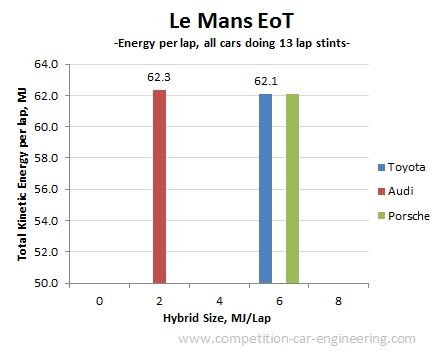I've just been looking through the results, and I believe I'm correct in saying that all three manufacturers were doing 13 lap stints the majority of the time. (it was difficult to follow this in the race because the cars quite quickly got out of sync due to various incidents).
Under these circumstances we can construct another chart showing how much kinetic energy each manufacturer had (on average) over those laps where the limit is the lower value of (fuel capacity/no. of laps + Hybrid allowance per lap) or (ACO fuel limit per lap + Hybrid allowance). It turns out that at 13 lap stints, all cars were limited by the ACO per lap limit, and none of the cars were limited by the fuel tank capacity.

So, due to the EoT Audi had a 0.2MJ per lap advantage over Porsche and Toyota, and no difference in stint length. Given that the cars were doing average lap times in the 205 second area, and assuming the car is accelerating (or at WOT) for 80% of that time (164 seconds), that is an average of 1.21 kJ/second, or 1.62 bhp advantage to Audi.
What is slightly surprising is that, according to the EoT tables, Porsche and Toyota,
should have been capable of doing 14 lap stints without any fuel saving, or maybe 15 with a little bit of fuel saving..... and yet it appears they weren't.....




